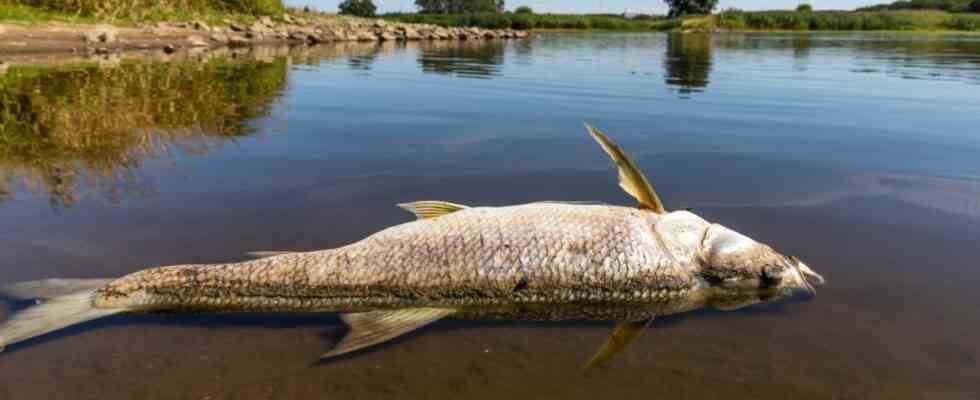Five months have passed since the Oder disaster, in which more than a thousand tons of fish died. Christian Wolter, fish ecologist at the Leibniz Institute for Freshwater Ecology and Inland Fisheries in Berlin, was involved in clarifying the cause. It is now clear that the damage to the ecosystem is immense – and the catastrophe could repeat itself. In an interview with the SZ, Wolter explains what needs to change.
SZ: Is the Oder doing a little better now?
Christian Wolter: The oxygen content has now normalized in winter due to the lower temperatures. Of course that’s good. However, the communities in the river have not yet had the opportunity to recover. Most fish and other organisms are in some form of hibernation. We can therefore only judge whether the fish have recovered in the spring, when they have spawned and perhaps new animals have migrated from tributaries. Two species of fish were lucky because they were not in the Oder at the time of the catastrophe in August: the large burbot and the Baltic houting. Both only migrate from the Baltic Sea in November to spawn in the Oder. Both seem to be doing well, at least we have seen several specimens of both.
What about other species?
little fish. In the spring before the catastrophe, we caught 1500 specimens of the guester, one of the main fish species in the Oder, on the stretch from Hohensaaten to the Marienhofer weir. In the fall after the disaster, there were only eight left in the same section. We didn’t catch any zopen or asp; not a single gudgeon, in the spring there were more than 200. The burglaries are massive.
The fisheries biologist and fish ecologist Christian Wolter from the Leibniz Institute for Freshwater Ecology and Inland Fisheries in Berlin helped solve the mystery of the dead fish in the Oder last year.
(Photo: Frank Hammerschmidt/picture alliance/dpa)
Does that mean that these fish no longer exist in the Oder?
No, we only drove a precisely defined route. Luckily these fish are still found elsewhere in the river. Large specimens of some species such as lead, zander and pike survived the catastrophe; this is important because large animals also produce a lot of spawn and provide for a lot of offspring. So there is recovery potential. The prerequisite, however, is that the water parameters do not deteriorate again.
Are there any signs?
Yes, the water of the Oder is still far too salty. This is shown by conductivity measurements. Last week the value at the Frankfurt gauge was 1400 microsiemens. In autumn, the values were repeatedly more than 2000 microsiemens.
Does that mean that despite the disaster in the summer, saline wastewater will continue to be discharged into the Oder?
Yes, exactly! And like in summer, it’s sodium chloride, i.e. table salt, that’s what my colleagues in the laboratory found out. That really shocked me, especially since there is even a conductivity limit of 850 microsiemens in Poland. In Germany, a guide value of 200 milligrams of chloride per liter applies. In the Oder, this value has been continuously exceeded since 2015. This is known, but nobody does anything about it.
Does that mean that the disaster will repeat itself next summer?
If nothing changes, it is very likely. Table salt is exactly the substance that the brackish water algae Prymnesium parvum needs…
So the algae that multiplied en masse in the summer due to the high salt content in the Oder and produced a toxin that was the cause of the fish die-off.
Yes, exactly! Permanent stages of this alga can certainly still be found in the Oder after the mass proliferation last year. If the salt concentration stays high and the temperatures rise again, the algae have ideal conditions and will most likely reproduce again and form the toxin.
Do you now know who discharged the saline sewage into the Oder and apparently still discharges it?
no What is certain, however, is that it is happening somewhere in Poland, because the Oder arrives in Germany with this high level of conductivity.
It should actually be possible to find out by measuring where the salinity suddenly rises and then looking at which companies are there.
Yes, that shouldn’t be that difficult, but I don’t have any official conductivity values from Poland. With the help of satellite images, it was possible to determine where the concentration of chlorophyll a suddenly increased in summer, i.e. where algal blooms had formed. Whether they were Prymnesium parvum flowers and whether the salinity was high in these places could only be determined from water samples. However, it may not be politically desirable to find someone to blame. My hope is that now that the temperatures are cool and algae growth is slower, tanks or reservoirs will be emptied with waste water so that nothing is discharged in the summer. I hope for the Oder that, despite everything, those responsible learned something from the disaster in the summer and that they realize that something like this shouldn’t happen again.
What if it happens again?
That would be the GAU. I do not believe that the Oder could then recover. But I don’t like to imagine that at all.
Before the disaster, the only population of the Baltic goldwolf in Germany lived in the Oder near Reitwein. Do you know if these rare fish survived?
We checked at Reitwein and didn’t find a single gold wolffish. I thought the population had gone extinct, but then we spotted ten more goldfinfish at another spot further upstream. Perhaps a population had existed there for a long time, previously unrecognized, or the fish fled there from the poison wave. It is important: the Goldsteinbeißer is still in the Oder. That made me very happy.

